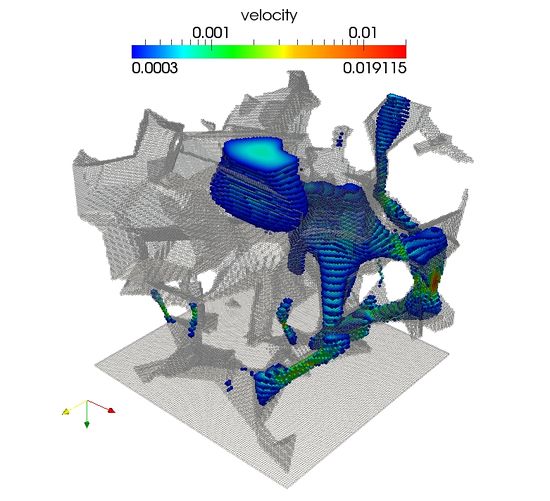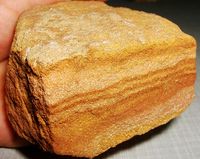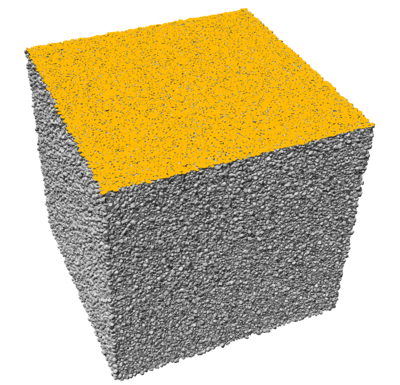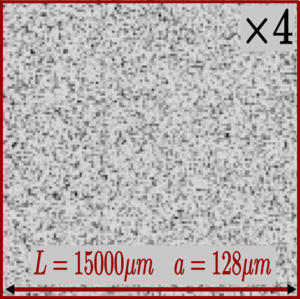Thomas Zauner
PhD student
| Office: | 202 |
|---|---|
| Phone: | +49 711 685-67652 |
| Fax: | +49 711 685-63658 |
| Email: | Thomas.Zauner _at_ icp.uni-stuttgart.de |
| Address: | Thomas Zauner Institute for Computational Physics Universität Stuttgart Allmandring 3 70569 Stuttgart Germany |
Research Overview
The general field of my research is the computational investigations of natural porous media. A typical example of such a natural porous medium is sandstone. It consists of very small consolidated grains that form a solid backbone but, due to the space between individual grains, is permeable for fluids. Physical transport phenomena of natural porous media, such as flow rates, trapping behavior and prediction of effective transport coefficients, have always been of great practical interest for the oil and gas industry and has currently drawn public attention in the context of CO2 sequestration. Many industrial applications use porous materials. Examples are fuel cells, filtration processes, catalyst in chemical reactions or building materials with special physical properties.
The scientific problems I address in my work are:
- Developing algorithms that generate realistic and macroscopic computer models for granular porous media. These models are made of several hundred millions of individual grains whose positions, orientations and sizes must fulfill certain correlations and constraints. The associated large computational demand requires efficient and highly scalable parallelized algorithms.
- Identifying and evaluating numerical methods that allow accurate and predictive calculations of physical properties of porous media. These calculations typically require numerically solving partial differential equations within a chosen discretization scheme and at a specific resolution or order of accuracy.
Realistic computer models for granular porous media
In the reconstruction procedure a dense packing of spheres is created. The packing must fulfill given constraints such as density, overlap, size distribution and others. The spheres are later substituted by more complex geometrical objects determined by the shapes of the grains used. One option is to use polyhedrons as grain shapes. The resulting model is a continuum model. The grain centers, sizes and orientations are continuous in space and the grain shapes are analytical defined. An example of such a model for Fountainebleau sandstone is shown in image 1. The continuum computer model can then be discretized at any desired resolution (image 2) for further analysis and computer simulations.
Flow Simulations
The permeability of a porous medium is an example of a physical transport parameter. It describes the mediums ability to transmit fluid flow through it. Using Darcy's law the permeability of a porous medium can be calculated from the velocity and corresponding pressure field on the porescale. These fields are solutions of porescale hydrodynamic partial differential equations. Different numerical methods that solve different hydrodynamic equations can be used to obtain the velocity and pressure field. Possibilities are Navier-Stokes simulations and Lattice-Boltzmann simulations. Our Lattice-Boltzmann implementation, for example, numerically solves the Boltzmann equation and is run until a stationary solution has been reached. From this stationary solution the hydrodynamic fields are calculated. Simulations in stochastic geometries often require very large system sizes to obtain representative solutions. In our investigations, typical sizes of the discretized system are in the range 1024³-4096³ voxel.

Publications
[1] A. Narvaez, T. Zauner, F. Raischel, R. Hilfer, J. Harting, “Quantitative analysis of numerical estimates for the permeability of porous media from lattice-Boltzmann simulations”, Journal of Statistical Mechanics, P11026, 2010, Preprint
[2] S. Grottel, G. Reina, T. Zauner, R. Hilfer, T. Ertl, "Particle-based Rendering for Porous Media", SIGRAD, 2010, Preprint
[3] J. Harting, T. Zauner, R. Weeber, and R. Hilfer Numerical modeling of fluid flow in porous media and in driven colloidal suspensions in High Performance Computing in Science and Engineering '08, edited by W. Nagel, D. Kröner, M. Resch, Springer ,2008. Preprint



